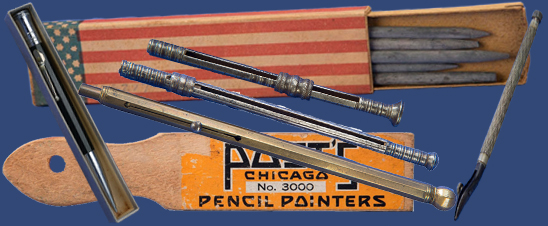This electric drafting tool consists of a 90" power cord, a motor in a 5" cylindrical black plastic casing, and a 1-1/2" aluminum collar in which is inserted a pink rubber eraser. The side of the tool has a label marked: DIETZGEN PowERaser (/) 115 V. • 0.35 AMP (/) AC • DC.
- Description
-
This electric drafting tool consists of a 90" power cord, a motor in a 5" cylindrical black plastic casing, and a 1-1/2" aluminum collar in which is inserted a pink rubber eraser. The side of the tool has a label marked: DIETZGEN PowERaser (/) 115 V. • 0.35 AMP (/) AC • DC. The end of the tool next to the cord is marked: DIETZGEN (/) NO. 3394 (/) ←OFF – 110 – 115V – AC-DC - ON→. A label around the cord about 10" from the plug is marked: Cab [illegible] Inc. (/) Inspected (/) Power (/) Supply Cord (/) P–732 (/) BELDEN (/) MFG. (/) CO. Masking tape is wrapped around the cord about 8" from the handle.
-
The Eugene Dietzgen Co. introduced model 3394A in 1938 for $6.50, increasing the price to $7.50 in 1943. Originally, the casing was shorter and the outside of the collar holding the eraser was smooth rather than threaded. The instrument was renumbered to model 3394, lightened from 14 to 12 ounces, and redesigned to the form of this object by 1948. Belden Manufacturing Company began making insulated wiring in Chicago in 1902. It manufactured only war materials during World War II, but it returned to supplying private firms such as Dietzgen in 1945.
-
According to the donor, this electric eraser was used by her husband, the electrical engineer Robert H. Wieler (1923–1993). He served in the U.S. Navy during World War II, attended Hofstra University in the early 1950s, worked for Sperry Gyroscope for 27 years, and then worked for Colt Firearms and Abraham Strauss of New York before retiring in 1985. Presumably he acquired the eraser during his studies or during his career at Sperry.
-
References: Catalog of Eugene Dietzgen Co., 15th ed. (Chicago, 1938), 352; Eugene Dietzgen Co., Price List No. 25 (Chicago, 1943); Eugene Dietzgen Co., Catalog 22D: Drafting Materials (Chicago, 1948), 106; Belden Inc., "Company History," http://www.belden.com/aboutbelden/company/history/; accession file.
- Location
-
Currently not on view
- date made
-
ca 1950
- distributor
-
Eugene Dietzgen Company
- maker
-
Eugene Dietzgen Company
- ID Number
-
1998.0032.15
- catalog number
-
1998.0032.15
- accession number
-
1998.0032
